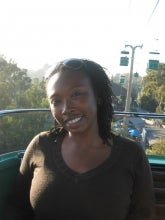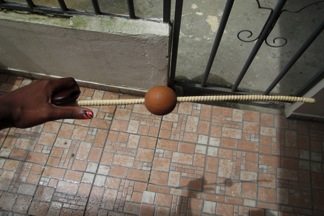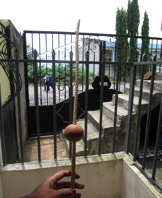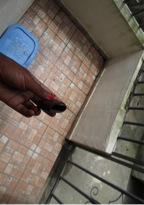Story of the Ahoko

I appreciate that Notes From The Field is a spacewhere unedited reality merges with the polished academy. It is akin to the Real World for budding ethnomusicologists—edited and crafted for its audience, but never the less fairly raw, inclusive of drama, romance, heartbreak, comedy, and meaningful information. These elements and emotions are all crucial components to our experience while in the field. Sadly, for academic and scientific purposes, such details are often omitted from many ethnographies. This omission, I believe, causes many to be blindsided when entering the field, where real world issues collide with our academic world.
For instance, in addition to participant observation, transcriptions, interviews, and recordings, many of us in the field have to discover how to efficiently: pop a squat, wash clothes by hand, cook over a gas tank or coal, fetch water, adjust to frequent power outages, cope with flooding, balance new relationships with work, deal with harassment (at all levels), all while surviving in a foreign land. Therefore, in an attempt to offer relief from the regular theoretical academic dialogue, I offer a piece that is both semi-academic and comedic. Which is actually how I have come to view most of my experience while in the field.
My Field

Image 1. Map of Abidjan and its Ten Communes. Image found on Wikimedia April 29th 2014.
My field's location, Abidjan, Côte d’Ivoire, has a population of over four million people—one of the largest cities in Africa. Côte d’Ivoire (pop. 22.8 million) has over sixty different ethnic groups within its borders, excluding the many immigrants from Liberia, Burkina Faso, Mali, Guinea, Ghana, and Nigeria, who have flocked to the country for jobs or refuge from war. Abidjan, former capital of Côte d’Ivoire, is a reflection of the nation’s diversity. The city is a dense maze of Ivoirians and those from neighboring countries and nations across the globe. As in most cities, it is primarily class, or socio-economic divisions which distinguish the city’s ten main communes: Cocody, Abobo, le Plateau, Adjame, Youpougon, Attécoubé, Treichville, Marcory, Koumassi, and Port Bouët.Ironically, the two most opposing communes are neighbors Cocody and Abobo. Cocody is the most “privileged” and economically stable quarter. Here, the water and electricity runs consistently, roads are paved, the police guide traffic, and residents dwell in villas and gated neighborhoods. In the neighboring commune—Abobo—one can experience the polar opposite, for it is the second most populous district, yet the poorest. There, few roads are paved, few buildings aside from the public housing complexes exist, most structures are shacks or makeshift homes, the police are rarely seen, traffic lights are non-existent, and the water and power are cut off daily. Abobo is commonly described as a faux quartier because it was formed by refugees and immigrants dwelling in public housing in the northern region of Abidjan, and through time the population grew exponentially as many immigrants continued to flood the capital in search of work and refuge from war. The remaining eight districts are primarily working class residential and/or industrial areas.
This represents the geographic layout and socio-economic extremes of my field. I travel by bus, gbaka (10 passenger mini-van, usually in horrible condition and crammed with more than 10 occupants), woro-woro (shared taxi), and private taxi across these communes observing, interviewing, and working with street children and organizations that aid and work with street children who dwell throughout Abidjan. With this population I observe the function of music among street children in various locations, on the streets and rescued in centers, and how they perform, use, and share music in their lives.
My experience, since arriving on October 2nd, has presented many scary, shocking, and amusing stories, but the one story that I am choosing to share today is one of being lost in translation (no relations to the film). I was introduced to an instrument, and as any true band dork and ethnomusicologist would be, I was eager to learn the instrument and its history. Below I will share how I was first introduced to the instrument, l’ahoko; how I came to own one and learn how to play it; and lastly the tragic tale of why this instrument now rests on my counter as a relic and will probably never be played by me again.
Warning: the comedic element in this story is for Mature Audiences only!
Introduction to the Ahoko
To better understand the music culture of Abidjan, I make it a point to attend as many musical events in Abidjan as possible in order to have knowledge, at some level, of the many different styles, genres, and major artists in Côte d’Ivoire. Such knowledge helps me to be more informed when the street children discuss and perform the different types of music in their lives. This reason, along with an invitation from a friend, drew me to the Daniel Pearl Music Days Concert at the United States Embassy on October 26th 2013 (Image 2). The primary agenda of this annual concert was to promote inter-ethnic and religious peace through music in Côte d’Ivoire.The concert featured three performers: Alima (Alimata Coulibaly, a Muslim songstress); Anges de Sions (Angles of Zion, a traditional Attie Christian vocal ensemble) and Yakomin (Afro-fusion jazz ensemble). The ensembles were strategically chosen to represent the Muslim, Christian, and indigenous religious presence in Côte d’Ivoire.
For the purpose of this article, emphasis will only be given to the Neo-Christian ensemble Anges de Sion. This vocal ensemble had three male vocalists and three female vocalists. The two oldest singers (one male and one female) were the lead vocalists. The ensemble, as common with most performances I have seen in Abidjan, performed to prerecorded music. Supposedly, this allows the artists to place more emphasis on dance and the playing of instruments, than singing. In the case of Anges de Sion, their instrument was the ahoko (Image 3). The instrument caught my attention because of its aural resemblance to the Latin American idiophone, guro. Their dance, contrary to the pelvis oriented coupé décalé dance moves popular throughout Abidjan, reflected the slower more grounded, slightly bent dance moves seen commonly among many Akan dances.

Image 2. Collaborative Performance at Daniel Pearl Music Days Concert at United States Embassy in Cocody, Abidjan, Côte d’Ivoire.
The performances are Alima (center); Anges de Sions (all those wearing pagne); and Yakomin (seated musicians behind the vocalists). Image found on website of the US Embassy in Abidjan.
Their attire consisted of traditional, thick woven pagne (fabric) generally made in the central and eastern regions of Cote d’Ivoire among the Baoulé (Akan ethnolinguistic group). The pagne was wrapped around the mens’ waists, while the females’ torsos and waists were both wrapped in pagne. The performers were barefoot with rattles to decorate their ankles and create a thick layering of polyrhythms between the prerecorded music, the ahoko, and their bell anklets. White circles adorned their exposed skin. And, as common among many Akan dances, white handkerchiefs were used during the partner dances. Although traditional Attie songs were performed, the bulk of the repertoire was renditions of Negro spirituals and Black gospel such as “Born in Bethlehem,” and “I Hear Music in the Air.” Strangely these songs were adopted to mid 20th century country and rock n roll rhythms. Though there are many interesting aspects of their performance to delve into, my focus will be on the traditional idiophone, the ahoko (Image 3).
Excitement for l’ahoko

Image 3. The ahoko. Image taken by author.
This seemingly simple instrument has three components: wooden rod with grooves- spiraled etched into its body. Hollowed out gourd, and a hollowed out flattened hull (Image 4). The hollowed gourd has two holes, which holds the gourd in place so that it can easily move back and forth on the stick. The hollow hull that is partially cut open is used as a resonator and alters the sound of the instrument, based on the placement of the thumb.


Image 4. Gourd and Stick/Flattened Hull. Images taken by author.
A few months later I met with Monsieur Jean Claude N’Guessan, the director of National Music at the Institut National Superieur des Arts et de l’Action Culturelle (INSAAC). To my surprise, lying there on his desk was an ahoko and as I glanced around, I saw that several others were scattered around his office. So, when he asked me how he could be of service, my first request was to learn the instrument and its history. That day I had my first informal lesson on the instrument. As Mr. N’Guessan is also a composer, he expressed how he uses the instrument in neo-traditional compositions and has created an orchestra of the traditional instrument based on varying gourd and hull sizes. In addition, he creates very intricate polyrhythms with the instrument unlike the simple patterns commonly played by performers (Image 5).
Discovering l’ahoko
As any band dork, I returned home super excited to master my new instrument. Intensely trying to learn and master the rhythms, beginning at half the tempo and eventually increasing the tempo. Later I would work on altering the sound with the placement of the hull (resonator) against the rod, and altering the varying degrees that the hull is open. It was a new toy that I was eager to learn and decipher. My neighbors (all male) would pass, give greetings and then ask of the noise. I’d tell them eagerly of how I was trying to learn the ahoko. With each eager description of the instrument and my newly learned polyrhythms, I was met with hearty laughter or a sly giggle. I would ask, “pourquoi tu ris comme ca?” (Why are you laughing?) Their response was always, “Ce n’est rien. T’aime l’ahoko?”(It’s nothing. You like the ahoko?) After a few weeks I just assumed that they were amused at how eager I was to learn a traditional instrument. Then I began to notice that I was met with the same response from everyone I spoke with about the ahoko. Finally, while having dinner with a friend, who also laughed at me, I demanded an explanation as of why everyone giggles and laughs when I tell them that I am learning the ahoko.
L’ahoko ≠ Traditional Idiophone
Nouchi is an argot spoken amongst urban youth in Abidjan. It has popularized itself throughout Côte d’lvoire and across socio-economic barriers through the popularity and spread of the music genres Zouglou and Coupé Décalé. While Ivoirian French is the foundation of this argot, the language also blends in words from several Ivoirian indigenous languages, such as Dioula, Bete, Baoulé, Attie, and lastly English. In addition to merging many different languages, Nouchi commonly recontextualizes many of its words, taking words and altering their meanings to something sexual or more pertinent to urban youth life.
The Nouchi recontexualization of the ahoko was the impetus of my mocking. While the ahoko is a traditional instrument, most Ivoirians no longer play the instrument. Because of its irrelevance to everyday Ivoirian urban life the name has captured a new meaning in Nouchi. As the instrument is essentially played by the rapid back and forth motion of a ball on a stick, the word ahoko has been redefined by youth in Abidjan to mean male masturbation, not the traditional instrument which can accompany traditional songs, dances, and storytelling.
Therefore, it was the most current definition of ahoko which dominated everyone’s thoughts and led to a good laugh and giggle as they inserted “to masturbate” each time I eagerly stated “I love the ahoko; I’m practicing the ahoko; A professor at INSAAC is teaching me the ahoko. . .” The list continues . . .
Nouchi
The exact origin of Nouchi is contested. Some say its roots are based in Guinea, while others, such as Simon Akindes states is based upon Moussa French, a creole originally created by Burkinabe immigrants. Akindes states its growth is due to its prevelance by workers in the maquis throughout the city (Mitter 2011). In either case the Manlinke people and their ethnolinguist group I a major component in constructing, only secondary to its Ivoirian French foundation. Although nouchi words, such as yaako (pardon) and togo (100 CFA) have infiltrated Ivoirian everyday language (I use the words myself), many frown upon its existence past merely being an argot. Others, including academics, have acted to accredit the language through dictionaries (Nouchi Dicctionnaire), websites (nouchi.mob; nouchi.comlist), apps, and its use in newspapers (Gbich), to accredit the language and demonstrate its true significance and presence in urban Ivoirian culture.
Aftermath
Sadly, after learning the most recent and popular definition of the ahoko, I have opted to stop taking lessons on the instrument. Once knowing the truth my thoughts remain irreversible. Similar to the general public, every time I speak of the ahoko or even ask for further information on the instrument, I think of its Nouchi definition rather than the object.
Such stories should be shared and documented just as the successful, academically acceptable moments. Much is to be learned from both experiences; and such experiences adds a sense of reality to the academy which ostracizes those not apart of the ivory tower and reeks often of staunch staleness.
Adding some humorous and some not so humorous, but true, details of our experiences in the field will reveal to all that: 1) we do not know nearly as much as we think we do; 2) life is full of unexpected events; 3) sometimes we have to just laugh at ourselves and allow others to laugh at us; and 4) laughing and crying are both healthy for the mind, body, and soul.
Works Cited
Akindes, Simon. 2002. “Playing it ‘Loud and Straight’ Reggae, Zouglou, Mapouka and Youth Insubordination in Côte d’Ivoire.” In Playing with Identities in Contemporary Music in Africa, edited by Mai Palmberg and Annemette Kirkegaard, 86-103. Uppsala: Nordiska Afrikainstituet.
Mitter, Siddhartha. 2011. “The Hip Hop Generations: Ghana’s Hip Life and Ivory Coast’s Coupé Decalé.” <www.afropop.org> Accessed April 12th 2012.
Nouchi.mobi
Nouci.comlist
Nouchi dicctionnaire





